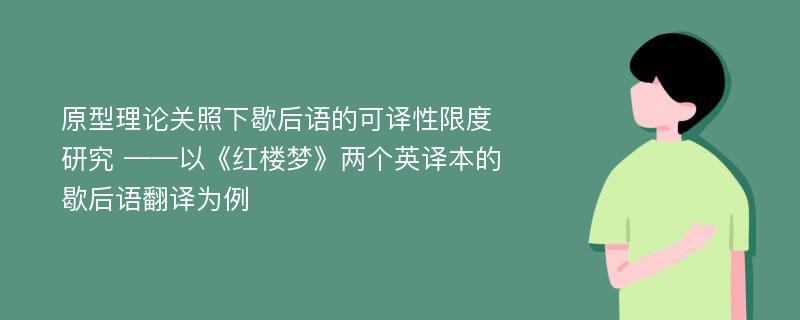
论文摘要
《红楼梦》是中国四大名著之一,以其丰富的文化内涵和极高的语言艺术享誉世界。在运用歇后语上,堪称典范。其中的歇后语符合每个人的身份、教养、性格、心理和具体情景,使得人物更加传神。然而,其独特的结构形式,浓厚的民族色彩使歇后语成了红楼梦翻译的难点之一。最有影响力的两个英文全译本:中国翻译家杨宪益与其夫人戴乃迭(Gladys Yang)合译的A Dream of Red Mansions及英国汉学家David Hawkes与其女婿John Minford翻译的The Story of the Stone中的歇后语也或多或少存在语言或文化方面的可译性限度。原型理论为这一论断提供了有力的理论基础。原型是对一类事物的抽象心理表征,整合了所有范畴成员的最典型的特征,是人类用以比较的认知参照点。其基本特点表现为抽象性、整合性、优先性和可扩展性。2004年,杨炳钧在原型理论的基础上提出了翻译原型论,给翻译研究带来了全新的视角。翻译原型论指出翻译就是在一定的时空条件下寻找最佳目的语样例的活动,其中原语最佳样例和目的语最佳样例应当具有最大程度的对应关系。由于翻译受时间、空间等客观因素的影响,受个人经验等主观因素的制约,寻找最佳样例是目标,不是结果。最佳样例具有罕见性,可译性限度在译者翻译过程的每个阶段都有可能出现。由于原型范畴成员典型程度的差异性,不同译作中有不同程度的可译性限度。本文旨在原型理论关照下探讨歇后语的可译性限度。为此,本文第五章以杨译本和霍译本中歇后语翻译为例,分析歇后语的意义,比较总结两译者具体使用的翻译方法,指出两位译者在翻译过程中造成的可译性限度并探讨降低可译性限度的可能因素。结果发现:两位译者选择的翻译方法非常相似,使用直译的比例最高,意译次之,借用英语习语的比例较低,两译者都有省略整个歇后语的现象,且为相同的两个歇后语。两译者各种方法的使用在一定程度上降低了可译性限度,并不能消除可译性限度。《红楼梦》两个全译本中歇后语的翻译并非原语原型的最佳样例,都或多或少存在可译性限度。这种可译性限度是译者主观因素所致,在译者寻找目的语读者原型,理解原语文本,寻找对应的目的语原型,使用目的语创建译文样例等每个阶段都有可能出现。这种结果表明:任何一种方法都不是万能的,任何一个译作中都可能有不同程度的可译性限度。然而,语言的发展,文化的相互渗透,译者综合能力的提高以及目标语读者审美能力的加强都将有效地降低可译性限度。最后,作者指出,任何一个原作都处于开放的状态,没有绝对权威的译本。随着语言的发展,文化的相互渗透以及人类思维能力的不断深化﹑认知世界的不断扩展,译者和读者越来越具备能够理解文化异质的认知能力,领略和欣赏文化异质的求新、求异、求真心理,相同的原作,不同的译者又会按照自身的认知世界去努力降低语言和文化可译性限度,寻找原语原型的最佳样例,生成更接近原型的译文。
论文目录
Abstract摘要List of abbreviationsChapter One Introduction1.1 Research background1.2 Purpose and significance of the research1.3 Introduction to Chinese folk wisecracks1.3.1 Structure of Chinese folk wisecracks1.3.2 Classifications of Chinese folk wisecracks1.3.3 Denomination of Chinese folk wisecracks in English1.4 Structure of the thesisChapter Two Literature Review2.1 Critical review of studies on the translations of Chinese folk wisecracks2.1.1 Linguistic perspective2.1.2 Cross-cultural perspective2.1.3 Rhetorical perspective2.2 Critical review of studies on limits of translatability2.2.1 Previous studies on limits of translatability abroad2.2.2 Previous studies on limits of translatability in China2.3 SummaryChapter Three Theoretical Framework3.1 Prototype category theory3.1.1 The definition of prototype3.1.2 The characteristics of prototype3.2 Prototype theory of translation3.3 Limits of translatability in light of prototype theory3.3.1 The rareness of the best exemplar3.3.2 The prototypical characteristics of category members3.3.3 Limits of translatability by the translator in translation process3.3.3.1 Searching for prototype of target text readers3.3.3.2 Obtaining an understanding of the source text which is close to the source text prototype3.3.3.3 Finding the correspondent target text prototype3.3.3.4 Recreating the understanding of source text in the target language3.4 SummaryChapter Four Research Procedure4.1 Research questions4.2 Research methods4.3 Data collection4.4 Data analysis4.4.1 Figurative Chinese folk wisecracks4.4.1.1 Literal translation4.4.1.2 Free translation4.4.1.3 Partly borrowing English idioms4.4.2 Punny Chinese folk wisecracks4.4.2.1 Literal translation4.4.2.2 Free translation4.4.2.3 Partly borrowing English idioms4.4.2.4 Fully borrowing English idioms4.4.2.5 Omission4.5 Results and discussion4.5.1 Translation methods of Chinese folk wisecracks in Hong Lou Meng4.5.2 Limits of translatability by the translator in the translation process4.5.3 Possible factors to minimize limits of translatability4.5.3.1 Assimilation of language4.5.3.2 Mutual infiltration of culture4.5.3.3 Improvement of the translators’ability4.5.3.4 Enhancement of the TT readers’abilityChapter Five Conclusion5.1 Major findings5.2 Limitations and further suggestionsReferencesAcknowledgementsAppendix
相关论文文献
标签:原型理论论文; 歇后语论文; 可译性限度论文; 红楼梦论文; 比较研究论文;
原型理论关照下歇后语的可译性限度研究 ——以《红楼梦》两个英译本的歇后语翻译为例
下载Doc文档
